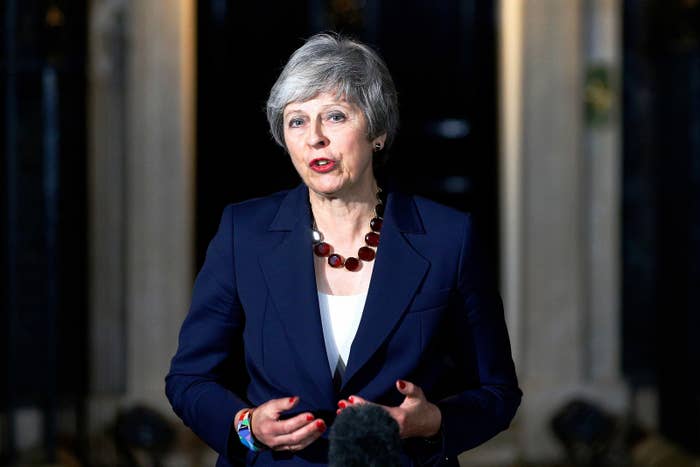
Theresa May secured the “collective support” of the Cabinet for her Brexit deal after a five-hour meeting in Downing Street, even as Eurosceptic Conservative MPs vowed to “imminently” trigger a vote of confidence in the prime minister.
Speaking outside 10 Downing Street after the marathon Cabinet meeting finally ended, May said the country faced a decision between her deal, no deal, or “no Brexit at all”.
She said she believed “with my head and my heart” that the agreement with the EU was “in the best interests of our entire United Kingdom”.
“This is a decisive step which enables us to move on and finalise the deal in the days ahead,” she said.
But Cabinet sources told BuzzFeed News between 8 and 10 ministers voiced their opposition to various aspects of the deal during the meeting.
Work and pensions secretary Esther McVey was the most strongly opposed to the agreement. Sources said she raised complaints about the backstop, that the UK could be prevented from striking free trade deals, and that there would be “chaos” if the government loses the vote on the deal in the Commons. She told the room she “can see lots of trouble on the way”.
McVey was also involved in a “massive row” after twice demanding the Cabinet be allowed to vote on the decision so ministers’ opposition could be put on the record.
She was “shouted down” by the Cabinet secretary Mark Sedwill and chief whip Julian Smith, a Cabinet source said.
Chief secretary to the Treasury Liz Truss told colleagues she was “caught between the devil and the deep blue sea”.
Damian Hinds, the education secretary, said he would have preferred there to be a unilateral break clause in the deal, but he would support it because it was better than the alternative.
Communities secretary James Brokenshire told the PM to “follow your judgment”.
It is understood that environment secretary Michael Gove, one of the leaders of the Leave campaign, was the only one of May’s senior ministers to speak up in favour of the deal, but in the end, a majority backed her.
In her public statement, the PM confirmed the Cabinet came to its “collective decision” after “a long detailed and impassioned debate”, adding: “These decisions were not taken lightly but I believe it is a decision that is firmly in the national interest.”
She admitted that “there will be difficult days ahead”, raising questions as to whether the ministers may yet resign.
She continued: “The choice was this deal which enables us to take back control and to build a brighter future for our country, or going back to square one with more division and more uncertainty.”
Even before the PM emerged to face the cameras to announce the Cabinet had backed her, members of the European Research Group of Brexiteer Tory MPs told journalists they would send letters of no confidence to 1922 committee chair Graham Brady, threatening to trigger a vote on Thursday.
ERG chair Jacob Rees-Mogg wrote to Tory MPs, saying he “could not support the proposed agreement and would hope that Conservative MPs would do likewise”. The deal would “treat Northern Ireland differently from the rest of the UK” and “lock us into an EU customs union”, he warned.
BREAKING: ERG chair @Jacob_Rees_Mogg says he cannot support PM’s deal and calls on other Tory MPs not to. But hasn’t called for her to go... yet. https://t.co/cBMr2NPsiU
May is tonight meeting Democratic Unionist party leader Arlene Foster to discuss the deal. Earlier on Wednesday, Foster said she would “not support a deal that broke up the United Kingdom” and that there would be “consequences” when it came to a vote in the Commons.
Scottish secretary David Mundell, who had been rumoured to be considering his position over the impact of the agreement on fishing, said he was not resigning.
“I am absolutely part of the Cabinet because I am satisfied with the deal,” he said, adding: “we are clear we are leaving it in 2020 and becoming an independent coastal state. I am satisfied that the deal will allow us to do that.”
Earlier in the day in Brussels, ambassadors from the EU’s remaining 27 member states were presented with a timeline outlining next steps.
European governments will be able to review the draft withdrawal agreement, the terms of the UK’s departure from the EU, and the outline of the future relationship. The EU27 ambassadors will meet at again at the end of the week.
Next week, emissaries and ministers from the 27 governments will aim to finalise the documents, and on Nov. 25, the remaining EU leaders and May will meet to conclude the agreement at a specially convened summit.
Diplomats were told at Wednesday’s meeting that the president of the European Council, Donald Tusk, doesn’t want next week’s meeting to turn into a drafting session. The aim of the meeting will be to simply agree the text.
After that meeting, May will have to get through her most difficult challenge yet — getting the deal through the UK parliament. Ministers believe she will need significant support from Labour MPs in order to pass her deal.
Northern Ireland Minister Shailesh Vara resigned from the government on Thursday morning in protest over Theresa May's deal.
"With respect Prime Minister, this Agreement does not provide for the United Kingdom being a sovereign, independent country leaving the shackles of the EU, however it is worded," he wrote in a letter to Theresa May.

